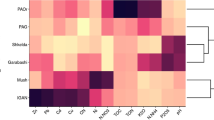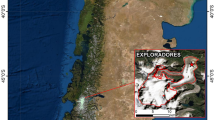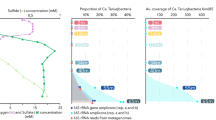Abstract
High-elevation cold environments are considered ideal places to test hypotheses about mechanisms of bacterial colonization and succession, and about bacterial biogeography. Debris-covered glaciers (glaciers whose ablation area is mainly covered by a continuous layer of rock debris fallen from the surrounding mountains) have never been investigated in this respect so far. We used the Illumina technology to analyse the V5 and V6 hypervariable regions of the bacterial 16S rRNA gene amplified from 38 samples collected in July and September 2009 at different distances from the terminus on two debris-covered glaciers (Miage and Belvedere—Italian Alps). Heterotrophic taxa-dominated communities and bacterial community structure changed according to ice ablation rate, organic carbon content of the debris and distance from the glacier terminus. Bacterial communities therefore change during downwards debris transport, and organic carbon of these recently exposed substrates is probably provided more by allochthonous deposition of organic matter than by primary production by autotrophic organisms. We also investigated whether phylotypes of the genus Polaromonas, which is ubiquitous in cold environments, do present a biogeographical distribution by analysing the sequences retrieved in this study together with others available in the literature. We found that the genetic distance among phylotypes increased with geographic distance; however, more focused analyses using discrete distance classes revealed that both sequences collected at sites <100 km and at sites 9400–13 500 km to each other were more similar than those collected at other distance classes. Evidences of biogeographic distribution of Polaromonas phylotypes were therefore contrasting.
Similar content being viewed by others
Log in or create a free account to read this content
Gain free access to this article, as well as selected content from this journal and more on nature.com
or
Accession codes
References
Ambrosini R, Møller A, Saino N . (2009). A quantitative measure of migratory connectivity. J Theor Biol 257: 203–211.
Benjamini Y, Yekutieli D . (2001). The control of the false discovery rate in multiple testing under dependency. Ann Stat 29: 1165–1188.
Benn D, Evans J . (2010) Glaciers and Glaciation 2nd edn. Hodder Education: London, UK.
Benson D, Karsch-Mizrachi I, Lipman D, Ostell J, Sayers E . (2010). GenBank. Nucleic Acids Res 38: D46–D51.
Borchard D, Gillet F, Legendre F . (2011) Numerical Ecology with R. Springer: New York, NY, USA.
Borin S, Ventura S, Tambone F, Mapelli F, Schubotz F, Brusetti L et al (2010). Rock weathering creates oases of life in a high Arctic desert. Environ Microbiol 12: 293–303.
Brankatschk R, Towe S, Kleineidam K, Schloter M, Zeyer J . (2011). Abundances and potential activities of nitrogen cycling microbial communities along a chronosequence of a glacier forefield. ISME J 5: 1025–1037.
Brock BW, Mihalcea C, Kirkbride MP, Diolaiuti G, Cutler MEJ, Smiraglia C . (2010). Meteorology and surface energy fluxes in the 2005–2007 ablation seasons at the Miage debris-covered glacier, Mont Blanc Massif, Italian Alps. J Geophys Res 115: D09106.
Caccianiga M, Andreis C, Diolaiuti G, D'Agata C, Mihalcea C, Smiraglia C . (2011). Alpine debris-covered glaciers as a habitat for plant life. Holocene 21: 1011–1020.
Caporaso JG, Kuczynski J, Stombaugh J, Bittinger K, Bushman FD, Costello EK et al (2010). QIIME allows analysis of high-throughput community sequencing data. Nat Methods 7: 335–336.
Caporaso JG, Lauber CL, Walters WA, Berg-Lyons D, Huntley J, Fierer N et al (2012). Ultra-high-throughput microbial community analysis on the Illumina HiSeq and MiSeq platforms. ISME J 6: 1621–1624.
Claesson MJ, O’Sullivan O, Wang Q, Nikkila J, Marchesi JR, Smidt H et al (2009). Comparative analysis of pyrosequencing and a phylogenetic microarray for exploring microbial community structures in the human distal intestine. PLoS One 4: e6669.
Claesson MJ, Wang QO, O’Sullivan O, Greene-Diniz R, Cole JR, Ross RP et al (2010). Comparison of two next-generation sequencing technologies for resolving highly complex microbiota composition using tandem variable 16S rRNA gene regions. Nucleic Acids Res 38: e200.
Darcy JL, Lynch RC, King AJ, Robeson MS, Schmidt SK . (2011). Global distribution of Polaromonas phylotypes—evidence for a highly successful dispersal capacity. PLoS One 6: e23742.
De Caceres M, Legendre P, Moretti M . (2010). Improving indicator species analysis by combining groups of sites. Oikos 119: 1674–1684.
del Rio TG, Abt B, Spring S, Lapidus A, Nolan M, Tice H et al (2010). Complete genome sequence of Chitinophaga pinensis type strain (UQM 2034T). Stand Genomic Sci 2: 87–95.
Diolaiuti G, D’Agata C, Smiraglia C . (2003). Belvedere Glacier, Monte Rosa, Italian Alps: tongue thickness and volume variations in the second half of the 20th century. Arct Antarct Alp Res 35: 255–263.
Diolaiuti G, Kirkbride MP, Smiraglia C, Benn DI, D’Agata C, Nicholson L . (2005). Calving processes and lake evolution at Miage glacier, Mont Blanc, Italian Alps. Ann Glaciol 40: 207–214.
Egli M, Favilli F, Krebs R, Pichler B, Dahms D . (2012). Soil organic carbon and nitrogen accumulation rates in cold and alpine environments over 1 Ma. Geoderma 183–184: 109–123.
Eskelinen A, Stark S, Mannisto M . (2009). Links between plant community composition, soil organic matter quality and microbial communities in contrasting tundra habitats. Oecologia 161: 113–123.
Fierer N, Bradford M, Jackson R . (2007). Toward an ecological classification of soil bacteria. Ecology 88: 1354–1364.
Franzetti A, Gandolfi I, Gaspari E, Ambrosini R, Bestetti G . (2011). Seasonal variability of bacteria in fine and coarse urban air particulate matter. Appl Microbiol Biotechnol 90: 745–753.
Frey B, Rieder S, Brunner I, Plotze M, Koetzsch S, Lapanje A et al (2010). Weathering-associated bacteria from the Damma glacier forefield: physiological capabilities and impact on granite dissolution. Appl Environ Microbiol 76: 4788–4796.
Ganzert L, Lipski A, Hubberten H, Wagner D . (2011). The impact of different soil parameters on the community structure of dominant bacteria from nine different soils located on Livingston Island, South Shetland Archipelago, Antarctica. FEMS Microbiol Ecol 76: 476–491.
Gobbi M, Isaia M, De Bernardi F . (2011). Arthropod colonisation of a debris-covered glacier. Holocene 21: 343–349.
Goransson H, Venterink HO, Baath L . (2011). Soil bacterial growth and nutrient limitation along a chronosequence from a glacier forefield. Soil Biol Biochem 43: 1333–1340.
Huber J, Mark Welch D, Morrison H, Huse S, Neal P, Butterfield D et al (2007). Microbial population structures in the deep marine biosphere. Science 318: 97–100.
Jiang H, Huang Q, Deng S, Dong H, Yu B . (2010). Planktonic actinobacterial diversity along a salinity gradient of a river and five lakes on the Tibetan Plateau. Extremophiles 14: 367–376.
King AJ, Freeman KR, McCormick KF, Lynch RC, Lozupone C, Knight R et al (2010). Biogeography and habitat modelling of high-alpine bacteria. Nat Commun 1: 3.
Knelman JE, Legg TM, O’Neill SP, Washenberger CL, González A, Cleveland CC et al (2012). Bacterial community structure and function change in association with colonizer plants during early primary succession in a glacier forefield. Soil Biol Biochem 46: 172–180.
Lauber C, Hamady M, Knight R, Fierer N . (2009). Pyrosequencing-based assessment of soil pH as a predictor of soil bacterial community structure at the continental scale. Appl Environ Microbiol 75: 5111–5120.
Laybourn-Parry J, Tranter M, Hodson AJ . (2012) The Ecology of Snow and Ice Environments. Oxford University Press: Oxford, UK.
Lazzaro A, Abegg C, Zeyer J . (2009). Bacterial community structure of glacier forefields on siliceous and calcareous bedrock. Eur J Soil Sci 60: 860–870.
Legendre P, Legendre L . (1998) Numerical Ecology 2nd English edn. Elsevier: Amsterdam, The Netherlands.
Lennon J . (2011). Replication, lies and lesser-known truths regarding experimental design in environmental microbiology. Environ Microbiol 13: 1383–1386.
Madigan MT, Martinko JM, Dunlap PV, Clark DP . (2009) Brock Biology of Microorganisms 12th edn. Pearson International Edition: San Francisco, CA, USA.
Mannisto M, Tiirola M, Haggblom M . (2007). Bacterial communities in Arctic fields of Finnish Lapland are stable but highly pH-dependent. FEMS Microbiol Ecol 59: 452–465.
Mapelli F, Marasco R, Balloi A, Rolli E, Cappitelli F, Daffonchio D et al (2012). Mineral–microbe interactions: biotechnological potential of bioweathering. J Biotechnol 157: 473–481.
Mapelli F, Marasco R, Rizz A, Baldi F, Ventura S, Daffonchio D et al (2011). Bacterial communities involved in soil formation and plant establishment triggered by pyrite bioweathering on Arctic moraines. Microbial Ecol 61: 438–447.
Michaud L, Caruso C, Mangano S, Interdonato F, Bruni V, Lo Giudice A . (2012). Predominance of Flavobacterium, Pseudomonas, and Polaromonas within the prokaryotic community of freshwater shallow lakes in the northern Victoria Land, East Antarctica. FEMS Microbiol Ecol 82: 391–404.
Mihalcea C, Brock BW, Diolaiuti G, D’Agata C, Citterio M, Kirkbride MP et al (2008). Using ASTER satellite and ground-based surface temperature measurements to derive supraglacial debris cover and thickness patterns on Miage Glacier (Mont Blanc Massif, Italy). Cold Regions Sci Technol 52: 341–354.
Moorhead DL, Lashermes G, Sinsabaugh RL . (2012). A theoretical model of C- and N-acquiring exoenzyme activities, which balances microbial demands during decomposition. Soil Biol Biochem 53: 133–141.
Nakawo M, Rana B . (1999). Estimate of ablation rate of glacier ice under a supraglacial debris layer. Geografiska Annaler 81: 695–701.
Nemergut DR, Anderson SP, Cleveland CC, Martin AP, Miller AE, Seimon A et al (2007). Microbial community succession in an unvegetated, recently deglaciated soil. Microbial Ecol 53: 110–122.
Nicol GW, Tscherko D, Embley TM, Prosser JI . (2005). Primary succession of soil Crenarchaeota across a receding glacier foreland. Environ Microbiol 7: 337–347.
Oksanen J, Kindt R, Legendre P, O’Hara B, Simpson G, Solymos P et al (2009) Vegan: Community Ecology Package, R package version 1.15-3.
Østrem G . (1959). Ice melting under a thin layer of moraine and the existence of ice cores in moraine ridges. Geograf Ann 41: 228–230.
Pelfini M, Santilli M, Leonelli G, Bozzoni M . (2007). Investigating surface movements of debris-covered Miage glacier, Western Italian Alps, using dendroglaciological analysis. J Glaciol 53: 141–152.
Pelfini M, Diolaiuti G, Leonelli G, Bozzoni M, Bressan N, Brioschi D et al (2012). The influence of glacier surface processes on the short-term evolution of supraglacial tree vegetation: a case study of the Miage Glacier, Italian Alps. Holocene 22: 847–856.
Philippot L, Tscherko D, Bru D, Kandeler E . (2011). Distribution of high bacterial taxa across the chronosequence of two Alpine glacier forelands. Microbial Ecol 61: 303–312.
R Development Core Team (2008) R: A Language and Environment for Statistical Computing. R Foundation for Statistical Computing: Vienna, Austria.
Roesch L, Fulthorpe R, Riva A, Casella G, Hadwin A, Kent A et al (2007). Pyrosequencing enumerates and contrasts soil microbial diversity. ISME J 1: 283–290.
Sanyika TW, Stafford W, Cowan DA . (2012). The soil and plant determinants of community structures of the dominant actinobacteria in Marion Island terrestrial habitats, Sub-Antarctica. Polar Biol 35: 1–13.
Sattin SR, Cleveland CC, Hood E, Reed SC, King AJ, Schmidt SK et al (2009). Functional shifts in unvegetated, perhumid, recently-deglaciated soils do not correlate with shifts in soil bacterial community composition. J Microbiol 47: 673–681.
Schloss P, Westcott S, Ryabin T, Hall J, Hartmann M, Hollister E et al (2009). Introducing Mothur: open-source, platform-independent, community-supported software for describing and comparing microbial communities. Appl Environ Microbiol 75: 7537–7541.
Schmidt SK, Reed SC, Nemergut DR, Grandy AS, Cleveland CC, Weintraub MN et al (2008). The earliest stages of ecosystem succession in high-elevation (5000 metres above sea level), recently deglaciated soils. Proc R Soc Ser B 275: 2793–2802.
Schumacher BA . (2002) Methods of the Detemination of Total Organic Corabon (TOC) in Soils and Sediments. NCEA-C-1282. United States Environmental Protection Agency: Las Vegas, NV, USA.
Schutte U, Abdo Z, Bent S, Williams C, Schneider G, Solheim B et al (2009). Bacterial succession in a glacier foreland of the high Arctic. ISME J 3: 1258–1268.
Schutte U, Abdo Z, Foster J, Ravel J, Bunge J, Solheim B et al (2010). Bacterial diversity in a glacier foreland of the high Arctic. Mol Ecol 19: 54–66.
Sigler W, Crivii S, Zeyer J . (2002). Bacterial succession in glacial forefield soils characterized by community structure, activity and opportunistic growth dynamics. Microb Ecol 44: 306–316.
Sigler WV, Zeyer J . (2002). Microbial diversity and activity along the forefields of two receding glaciers. Microb Ecol 43: 397–407.
Smiraglia C, Diolaiuti G, Casati D, Kirkbride MP . (2000). Recent areal and altimetric variations of Miage Glacier (Monte Bianco massif, Italian Alps). In Nakawo M, Raymond CF, Fountain A, (eds) Debris Covered Glaciers. IAHS: Wallingford, Seattle, WA, USA, pp 227–233.
Taschner S, Ranzi R . (2002). Comparing the opportunities of LANDSAT-TM and ASTER data for monitoring a debris covered glacier in the italian alps within the GLIMS project. Proceedings of the 22nd International Geoscience and Remote Sensing Symposium (IGRASS 2002) Vol. 2: 24–28 June 2002 Toronto, Canada, pp 1044–1046.
Wang Q, Garrity GM, Tiedje JM, Cole JR . (2007). Naive Bayesian classifier for rapid assignment of rRNA sequences into the new bacterial taxonomy. Appl Environ Microbiol 73: 5261–5267.
Wang Y, Qian P . (2009). Conservative fragments in bacterial 16S rRNA genes and primer design for 16S ribosomal DNA amplicons in metagenomic studies. PLoS One 4: e7401.
Zumsteg A, Luster J, Göransson H, Smittenberg RH, Brunner I, Bernasconi SM et al (2012). Bacterial, archaeal and fungal succession in the forefield of a receding glacier. Microb Ecol 63: 552–564.
Acknowledgements
We gratefully thank Alessia Sacchetti for help during field work, Rocco Piazza and Alessandra Pirola for their support during sequencing and bioinformatic analyses, Chiara Compostella for chemical analysis of debris samples and Daniel Said Pullicino for helpful discussion on OC sources. Comments from two anonymous referees greatly improved the quality of the manuscript. The work was partially funded by the 2008 MIUR PRIN grant (Grant No. 2008723SYJ_001) and by the 2010-2011 MIUR PRIN grant (Grant No. 2010AYKTAB_006) to CS, and by the 2009 FAR grant to RA.
Author information
Authors and Affiliations
Corresponding author
Additional information
Supplementary Information accompanies this paper on The ISME Journal website
Supplementary information
Rights and permissions
About this article
Cite this article
Franzetti, A., Tatangelo, V., Gandolfi, I. et al. Bacterial community structure on two alpine debris-covered glaciers and biogeography of Polaromonas phylotypes. ISME J 7, 1483–1492 (2013). https://doi.org/10.1038/ismej.2013.48
Received:
Revised:
Accepted:
Published:
Issue date:
DOI: https://doi.org/10.1038/ismej.2013.48
Keywords
This article is cited by
-
Geographical variability of bacterial communities of cryoconite holes of Andean glaciers
Scientific Reports (2023)
-
Glacial Influence Affects Modularity in Bacterial Community Structure in Three Deep Andean North-Patagonian Lakes
Microbial Ecology (2023)
-
Characterization of organic-rich mineral debris revealed by rapid glacier retreat, Indren Glacier, European Alps
Journal of Mountain Science (2021)
-
Vanishing permanent glaciers: climate change is threatening a European Union habitat (Code 8340) and its poorly known biodiversity
Biodiversity and Conservation (2021)
-
Goose and hare faeces as a source of nutrients and dissolved organic matter for bacterial communities in the newly formed proglacial lake Ventisquero Negro (Patagonia, Argentina)
Hydrobiologia (2020)



